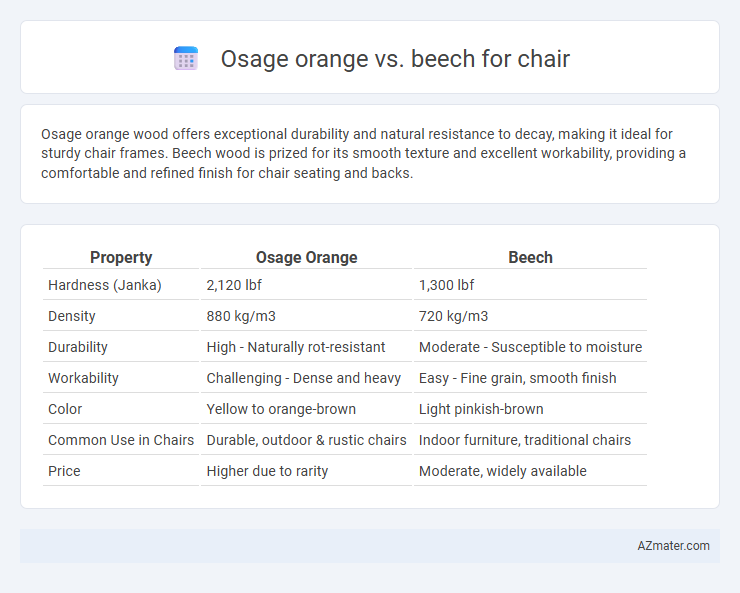Osage orange wood offers exceptional durability and natural resistance to decay, making it ideal for sturdy chair frames. Beech wood is prized for its smooth texture and excellent workability, providing a comfortable and refined finish for chair seating and backs.
Table of Comparison
| Property | Osage Orange | Beech |
|---|---|---|
| Hardness (Janka) | 2,120 lbf | 1,300 lbf |
| Density | 880 kg/m3 | 720 kg/m3 |
| Durability | High - Naturally rot-resistant | Moderate - Susceptible to moisture |
| Workability | Challenging - Dense and heavy | Easy - Fine grain, smooth finish |
| Color | Yellow to orange-brown | Light pinkish-brown |
| Common Use in Chairs | Durable, outdoor & rustic chairs | Indoor furniture, traditional chairs |
| Price | Higher due to rarity | Moderate, widely available |
Osage Orange vs Beech: Overview and Key Differences
Osage Orange wood is dense, durable, and resistant to wear, making it ideal for sturdy chairs needing long-term resilience, while Beech wood is lighter, easier to work with, and features a fine, consistent grain favored for smooth finishes and comfort. Osage Orange's natural resistance to rot and insect damage contrasts with Beech's moderate durability, which requires proper treatment to prevent decay. These differences influence the choice between Osage Orange for rugged, outdoor-style chairs and Beech for refined, indoor furniture with elegant appearance and ergonomic comfort.
Wood Hardness and Durability Comparison
Osage orange wood exhibits exceptional hardness, rating around 2,300 on the Janka scale, compared to beech's moderate hardness of approximately 1,300, making Osage orange highly resistant to dents and wear for chair construction. Its dense, tight grain structure also enhances durability, offering superior resistance to decay and insect damage compared to beech wood, which is more prone to moisture-related issues. Beech provides easier workability and a fine, even texture but lacks the long-lasting resilience and toughness that Osage orange imparts in high-use furniture like chairs.
Workability: Ease of Shaping and Finishing
Osage orange wood is dense and hard, making it durable but challenging to shape and finish due to its interlocked grain and high density, often requiring sharp tools and patience. Beech, on the other hand, offers excellent workability with a straight grain and fine texture, allowing for easier sanding, carving, and a smooth finish. For chair making, beech is generally preferred when ease of shaping and finishing is a priority, while osage orange excels in strength and durability but demands more effort during craftsmanship.
Appearance: Grain, Color, and Aesthetics
Osage orange wood exhibits a vibrant yellow-orange hue with a tight, interlocked grain pattern that offers a striking visual appeal for chair making. Beech wood features a pale cream to reddish-brown color with a fine, straight grain that provides a smooth, uniform surface ideal for classic and elegant chair designs. The bold coloration and unique grain of Osage orange create a more rustic, eye-catching aesthetic compared to the subtle, traditional look of beech wood.
Weight and Density Considerations
Osage orange wood features a high density around 56 lbs/ft3, making it significantly heavier and more durable for chair construction compared to beech, which has a moderate density near 43 lbs/ft3. The substantial weight of Osage orange contributes to enhanced stability and longevity in furniture applications, while beech offers a lighter option that is easier to handle but less dense. Understanding these weight and density characteristics is crucial for selecting the appropriate hardwood for chair durability and user comfort.
Resistance to Wear and Insects
Osage orange wood exhibits exceptional resistance to wear and insect damage, making it ideal for durable chair construction. Its high density and natural oils deter termites and wood-boring insects, outperforming beech wood, which is softer and more susceptible to abrasion and insect attacks. For chairs requiring longevity and robustness, Osage orange offers superior protection against daily use and environmental factors.
Availability and Sustainability
Osage orange is a hardwood known for its durability and natural resistance to rot and insects, but it is less commonly available in commercial lumber markets compared to Beech, which is widely harvested and easily sourced. Beech trees grow quickly and are often managed sustainably through responsible forestry practices, making beech wood a more eco-friendly choice for chair production. The relative scarcity and slower growth rate of Osage orange impact its sustainability profile, whereas beech offers a balance of availability and environmental consideration.
Cost and Value for Chair Making
Osage orange wood is dense and durable, offering excellent strength and resistance to wear, which can increase the initial cost but provides long-term value for chair making. Beech wood is more affordable and easier to work with, making it a popular choice for budget-conscious chair manufacturers seeking smooth finishes and good stability. While Osage orange demands a higher price, its longevity and hardness often justify the investment, whereas beech wood balances cost-effectiveness with reliable performance.
Comfort and Ergonomics Factors
Osage orange offers exceptional strength and rigidity, making it ideal for chair frames that require durability, but its hardness can reduce comfort without adequate cushioning. Beech wood provides superior shock absorption and a smoother finish, enhancing comfort and ergonomics by conforming better to the sitter's body and reducing pressure points. Both woods support ergonomic design, but beech's natural flexibility and warmth provide a more comfortable seating experience over prolonged use.
Best Choice: Osage Orange or Beech for Chairs?
Osage orange offers exceptional durability and resistance to decay, making it ideal for long-lasting chair frames, while beech wood provides a smoother finish with excellent workability, perfect for detailed craftsmanship and comfort. The dense, hard nature of Osage orange ensures structural strength but can be challenging to machine compared to the more pliable and lightweight beech, favored in ergonomic seating designs. For chairs requiring robust support and outdoor resilience, Osage orange is preferable, whereas beech excels in indoor furniture prioritizing aesthetic appeal and ease of shaping.

Infographic: Osage orange vs Beech for Chair
 azmater.com
azmater.com